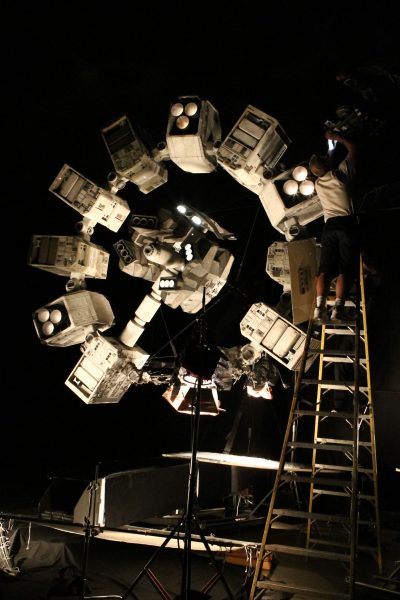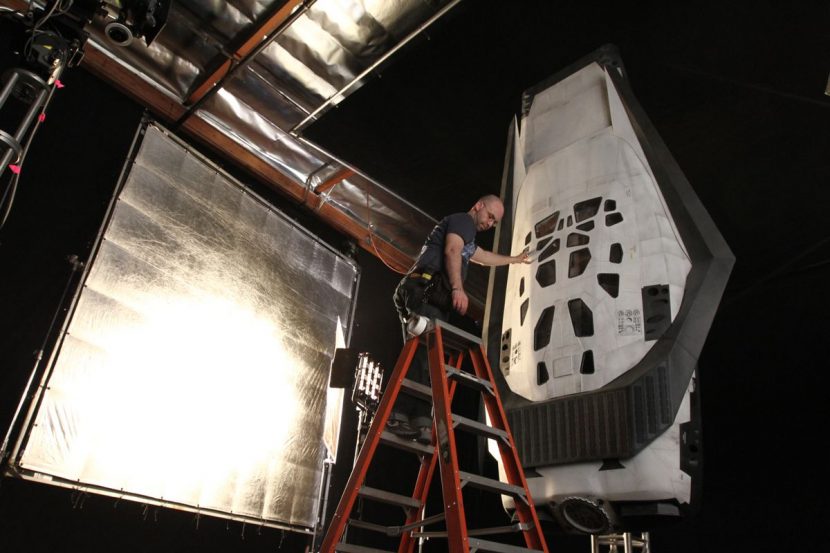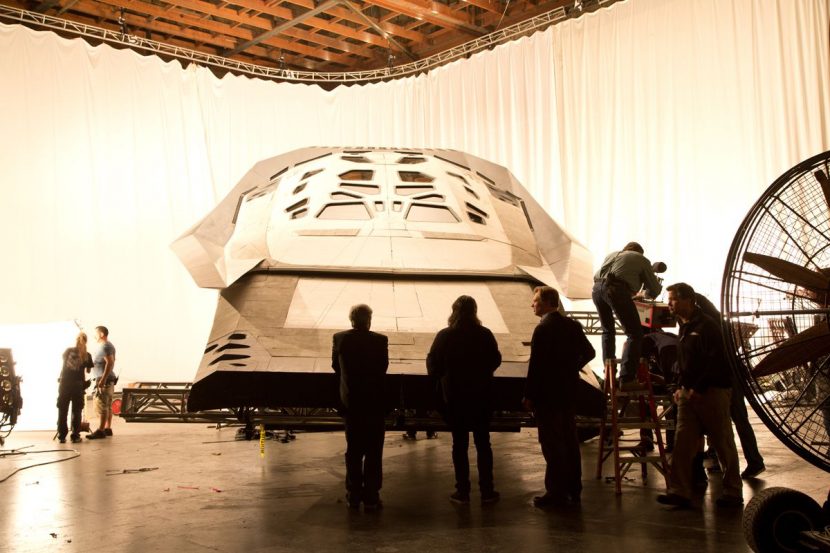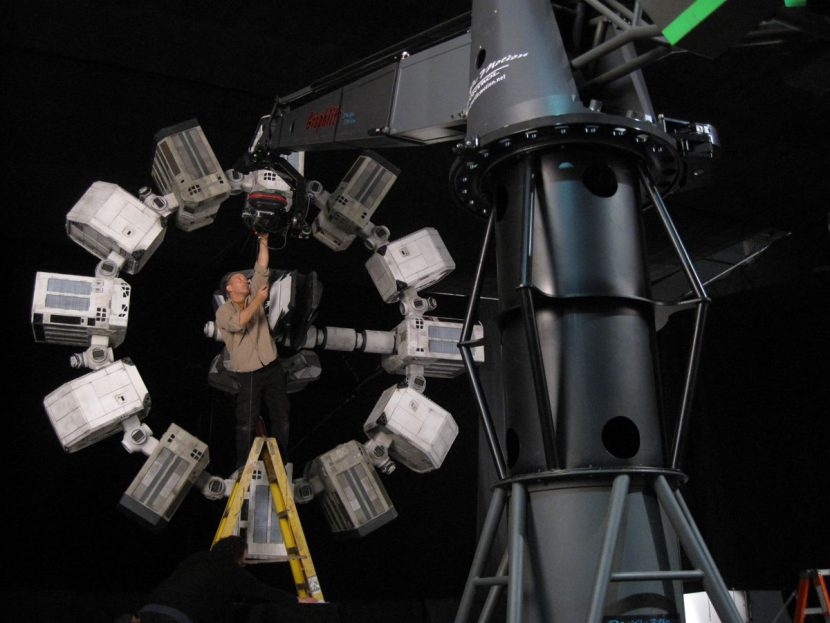‘You need to attach the camera to the model,’ commented Interstellar director Christopher Nolan to Ian Hunter, the visual effects supervisor from New Deal Studios responsible for overseeing the film’s miniature effects, including the current scene Nolan had been reviewing of the spaceship Endurance being badly damaged after a docking accident. ‘But the model explodes,’ noted Hunter, concerned that an expensive VistaVision camera might become no more. But Nolan was resolute. ‘Yes, but you need to attach the model to the camera.’
Nolan’s wish to replicate space shots achieved in principal photography, where an exterior camera was literally bolted to the side of the spacecraft, was one he felt should also be achieved in the visual effects world. “Of course,” says Hunter, “we did it with a special rig and that shot turned out to be incredible. I’ve never worked on one of Chris’ shows where he doesn’t throw some almost insurmountable challenge at you. He doesn’t do it to be hard, he does it to get a good shot.”
Indeed, New Deal Studios is no stranger to Nolan’s style, having previously crafted a miniature Batmobile and garbage truck for The Dark Knight, created planes for The Dark Knight Rises and then destroyed the hospital fortress in Inception. On each occasion, Nolan had sought out miniatures as a means of creating shots with the most visceral feeling as possible, then often combining them with full practical builds and digital visual effects. That same approach was taken on Interstellar. Here, New Deal was tasked with constructing miniature versions of the film’s spacecrafts that would be intercut with full scale props devised by production designer Nathan Crowley and digital models produced by Double Negative, overseen by overall visual effects supervisor Paul Franklin and Dneg’s Andrew Lockley.
Model building
The Endurance
Although the Ranger and Lander crafts were built full-size by production, the Endurance – outside of interior sets – would only be realized on screen via miniature and digital effects. New Deal Studios would be handling close and medium shots of the long-range spacecraft, in particular, and were therefore called upon to flesh out initial designs done by Nathan Crowley’s team. “We took Nathan’s basic shape and we worked also with concept artist Steve Burg on the details on the surface,” outlines Hunter. “The movie takes place in the near future and Chris wanted it to feel familiar. He wanted the ships to be based on existing NASA details and textures, but applied to these different shapes.”

New Deal Studios built a study model of the Endurance that was four feet across and based on 3D models worked up in MODO and Rhino. “From those 3D models we rapid prototyped surfaces and shapes for the engines and for the pods and airlocks and details,” says Hunter. “We assembled that study model and we would go through different iterations of that with different details and different paint.”
From that study model, the studio then went into building a shooting model at 1/15th scale – ending up with a miniature that was 14 feet across. “We built it with a steel armature and then rapid prototyped the details,” explains Hunter. “We molded those details and replicated them through 12 different pods that make up the Endurance.”
For filming, the Endurance was fitted with separate motion control mounts since the spacecraft would also have Lander and Ranger crafted docked to it. “So for shots of Cooper docking his Ranger ship with the Endurance we had to remove our miniature Rangers and be able to shoot the background plates of the Endurance without them,” notes Hunter. “After they’re docked on there, we could attach our separate Ranger ships and shoot shots with the Rangers, Landers and Endurance altogether, which we dubbed the ‘full stack’ whenever it had the complete set of ships on there.”
Rangers and Landers
As noted, New Deal Studios followed production designs for the miniature Ranger and Lander craft. The Ranger – a fast, sleek scout ship – was built 1:1 for studio shooting and for scenes shot in Iceland, and then replicated as 1/15th and 1/5th scale miniatures. “It’s decorated or covered with familiar NASA-inspired surfaces and textures,” says Hunter. “The bottom’s very reminiscent of the space shuttle heat shield and the top has the quilting too. So what this really does is help the audience identify with these ships and believe them.”

The Lander was intended to have a more rugged design. “One of the things that production identified was that the NASA craft are white and black and that’s pretty much the dominant color scheme,” states Hunter. “But Nathan wanted to make sure that with the Landers, the implication is that they can go to planets and start settlements, that those be a slightly different color. So the Lander – the more pickup truck version – has a lot of heat tile textures on it.”
The Ranger and Lander ships were CNC cut body patterns with rapid prototyped details. New Deal Studios made molds and also lightweight epoxy copies. “The reason for the copies,” says Hunter, “was that we needed two of them, so we put a lot of effort detailing the pattern and then could go from there to create the duplicates. We also wanted to try and make sure the Endurance as lightweight as possible. We actually mounted the Endurance and the Ranger and Lander ships onto a separate model mover that was a big cruciform shape that could spin.”
With shots planned to intercut between the full-size props, digital models and the miniatures, New Deal Studios had to slavishly follow the production designs – and even make some unexpected changes to the Ranger after the life-size prop was filmed in Iceland. “They built the prop here in the U.S. but had to cut it apart to get on the airplane,” recalls Hunter. “Once they put it back together there were seams left on some of the parts. Chris actually thought that the seams felt like details – that they looked like panel lines. And so he didn’t have them fix the seams because he thought they added a little bit of detail. So Chris had Paul Franklin bring us photographs of these seams they had cut into the prop, and we basically incorporated those onto the models.”
More details were infused, too, in the miniature interiors, with New Deal Studios even crafted a miniature Cooper pilot. “It was almost impossible to see but we made sure things like that were in there,” says Hunter. “I sculpted a pilot figure and we cast those up and posted them inside. We also put rudimentary figures and shapes in the Lander, Ranger and Endurance just so if you saw through the windows you wouldn’t see through to nothing.”
Model shooting
As it had done with the model builds, New Deal Studios also followed a more ‘realistic’ approach with filming VistaVision motion control and miniature plates – that meant visual effects DOP Timothy Angulo had to depart from the usual multi-pass method. Explains Hunter: “In traditional motion control photography, typically you shoot your beauty pass, your key light, your fill pass and then you shoot the practical lights and interior lights at different exposures. And you would do these all in separate passes, and then in compositing you put those altogether and that’s where you get the final look.”

“But because Chris wanted it to feel like real photography,” adds Hunter, “he wanted any artifact that would have occurred with real photography to be baked in to the shot. So he asked us to shoot the fill light, key light, practical and interior lights all as one pass – so that all the exposures were correct. That meant he was getting pure images for the ship. The result is that it looks very much like a documentary made movie.”
That realistic approach to lighting also aided in selling moving shots in space, such as when the Endurance is rotating as it creates an artificial gravity. “We wanted to rotate the model during photography so that we would get moving shadows,” explains Hunter. “With a locked off key light and rotating the model during photography, we again created a pure image of the moving shadows, as you would expect to see during the gravity generating parts of the shots.”
New Deal Studios based all of their shots off initial previs from Double Negative, although departing from the animatics where necessary when Nolan indicated it was only intended to be a rough guide. “What Chris told us is that previs is a guideline,” says Hunter, “but really what you’re looking at is the story you’re trying to tell in the previs shot. If it’s about the engines starting up or the ships spinning or the wormhole, whatever the story point is, put your camera on it and if you can find a better angle of the ship, you have the privilege of having the ship in front of you – if you find a better shot or a pan, do that. It actually freed us up and we shot faster because we were able to find angles quicker.”
Endurance explodes
What happens: Dr Mann unsuccessfully attempts to dock to the Endurance in a Ranger. The depressurization causes the Endurance and Ranger to partly explode.
The build: New Deal Studios constructed a 1/5th scale Ranger and a 1/5th scale quarter section of the Endurance for the sequence. “Those were CNC cut patterns for the Ranger body,” says Hunter, “with RP’d detail patterns that were molded and cast and applied to it and then we molded the ship and made it out of a breakaway material resin and foil so that we could have it come apart in the take. The Ranger was built and attached to a quarter section in fifth scale of the Endurance itself. And that was attached to a rock ’n’ roll truss frame and hung outside from a construction crane.”

Debris: Since the depressurization was to cause a stream of debris, New Deal Studios closely followed the Dneg previs to work out the scene dynamics. “Our digital effects supervisor Jeff Jasper ‘traced’ the direction the debris would take if gravity was making it fall,” notes Hunter. “We then hung the digital model upside down and at a slight angle, so when the debris fell, instead of it looking like it was falling as if it was on Earth, it looked more like it’s flying out at the camera. So we ended up hanging the real model at this weird angle outside to get that happening during the shot.”
The shoot: Senior effects technician Scott Beverly engineered the Endurance, Ranger and model mover for the shot. “His primary goal was to build this inverted upside down oddly hanging version of the Endurance, along with the Ranger and their separation,” says Hunter. “Inside he had a steel frame that was held together with cables and then those cables could be cut at a specific time and pattern so the ship itself could lose its integrity and come apart.”
Explosion: “The pyro for that scene was done by Richard Helmer,” relates Hunter. “His challenge was that it was a space explosion and we wanted to pursue a very realistic look for it. So when there’s oxygen present you’ll see flame, but as soon as the oxygen flies out into space, the flame should go away, but we still need to see debris flying. So what we came up with was a very quick burning flash explosion that’s inside the ship that dissipates very quickly. Then we had air cannons full of debris that would continue to fling debris out as the explosion is taking place. Normally for pyro you have flames that linger but in this case Richie was using butane for exploding which had a bright flash and burnt very quickly and dissipates.”
A surprise request: For the explosion, New Deal Studios had filmed one take with a crane from a safe distance, wary of damaging the camera. But Nolan wanted to match the look he had established earlier in full size shots where the camera was attached to the side of the ships. He asked Hunter to attach the camera to the model as it explodes – a task that required some fast-thinking innovation.
“We came up with something we called the ‘Pelicam’,” says Hunter. “We took a Pelican case – a durable equipment case – and we cut a hole in it and mounted our VistaVision camera inside the case. We attached it to the nose of our exploding breakaway Ranger, and then we took a pyrotechnic ‘Sweeney’ trip and attached it to the nose of the Ranger. And that’s what held the Pelicam in place. The Pelicam had a cable going off to the crane above like a tether. So it actually rode the exploding Ranger for several frames, and then at a specific point we could cut that cable and let the camera free to get it out of harm’s way. In the end both takes are in the movie.”
Spinning and docking
What happens: After the explosion caused by Dr Mann’s actions, Cooper determines to dock the Lander he is in with Amelia and TARS to the now violently spinning Endurance.
Match-cuts: Hunter notes that the principal photography by DOP Hoyte Van Hoytema led the miniatures effects. “Hoyte shot the full size Lander prop with spinning lights on the motion base that Scott Fisher the special effects supervisor had built. Those were our ‘A’ foreground plates. We took those and matched the lighting and position of our 1/15th scale Endurance. In this case, instead of it being hung vertically from our model mover, we hung it horizontally upside down and put our light on the other side and flipped the camera over, so it appeared to be spinning above us when in fact it’s below us.”
See some of the New Deal Studios’ key shots in the film’s trailer.
“Then there was a full sized docking arm that was shot by first unit,” adds Hunter. “That was stationary but with a moving light and then we matched the light position so when we spun our miniature those two could be sync’d up. If the full sized docking arm was there and you saw where it actually connected to the Endurance, in that case Paul Franklin felt that the digital version was a better match because he could line that up more accurately than we could have with our miniature. If you look carefully at the shots – the foreground would be full-sized, the background might be digital but whenever you’re looking across the Lander and you don’t see the connecting point between the docking arm and the Endurance, then more likely it’s our physical model being shot for that.”
Entering the black hole
What happens: TARS and Cooper use the remaining Ranger to head into the black hole and are bombarded by debris.
Ranger build: New Deal Studios had built a further 1/5th scale Ranger model from fiberglass, intending to use it to shoot parts of Cooper’s nightmare in which he re-lives an earlier test-flight crash. “But by the time we had that built – we were building and shooting while they were still doing a lot of the first unit photography – they had already shot it as a live action piece,” says Hunter. “So we still had this model left, and then as the movie was being cut together, Chris wanted to see the Ranger getting affected as it approaches the black hole. So that fifth scale model became a hero model that we could shoot very close to be the exteriors.”
Debris: As the Ranger pushes into the black hole, pieces of debris hit its surface. New Deal Studios came up with a unique solution for showing the bombardment. “We stood the model up outside vertically, and again using gravity as our friend, actually bombarded it with different materials as it entered the black hole,” explains Hunter. “Chris wanted something organic to keep the shots grounded in reality. So we ended up doing something simple – well – it sounded simple, but it actually got complicated – we dropped salt on it from above. We would stand the model up, and shooting against the black sky we put a lift outside of the range of the key light so that it was in darkness, and then we would off a slant board we would drop salt and shoot it at high speed as it fell towards the ship.”
“This weird veil of material would come down and hit the ship, and we shot that on its own separately for Cooper’s POV,” continues Hunter. “It was a very interesting-looking effect because it wasn’t a particle system, it wasn’t anything you’d expect to generate from an animation program. It was a strange physical phenomena we were catching. Of course the slightest wind would blow the shot! In order to get the height we shot outside, but it needed to be dead calm to do it.”
Other ‘old-school’ effects techniques also helped sell the debris shots. “We started shooting burning steel wool through an air mover at the ship,” says Hunter. “And for a super close-up we had a tilt lens to keep it in focus from lens to tail, and we actually applied layers of silver leaf to the model and then painted over them to match the ship. Then we used compressed air to blow that silver leaf off to make it appear to show the paint was peeling off the ship.”
Real and raw
“I think if Chris Nolan could have built a spaceship and just shot it in space, he probably would have preferred that,” reflects Hunter on the style of filmmaking the director imposed for Interstellar. “He likes to shoot things as real as possible, so in the case of the miniatures, it’s the next best thing. We’ve built a real model, we’ve put it out with real lighting on it in a real shooting environment and we’ve photographed what we’re seeing for real. There’s one less thing you have to get the audience to buy because they’re actually looking at something that is real. Subconsciously they know it’s really there in front of the viewer. It’s not a fantasy, it’s a drama that just happens to be taking place in space.”
